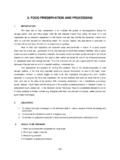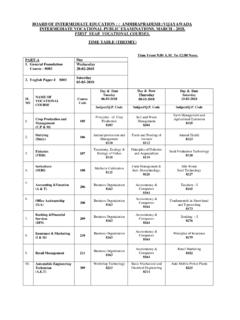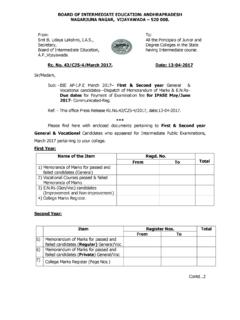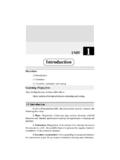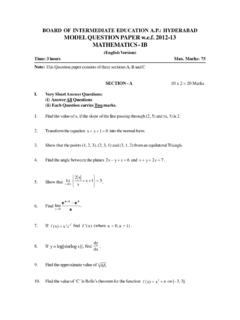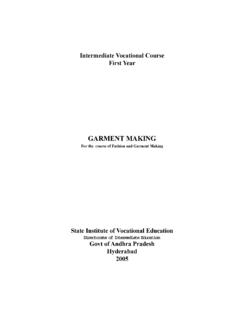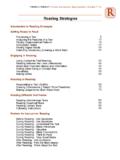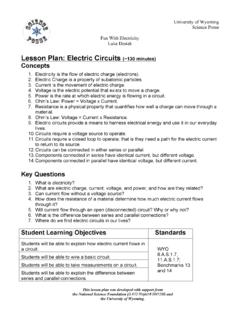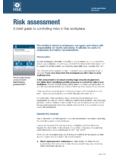Transcription of Classification and general properties of textile fibres
1 Classification of textile general properties of textile Difference between cellulose and synthetic fibresLearning ObjectivesAfter studying the chapter you will be able to understand various termsassociated with fibers. Classify the textile fibers. List out various general properties of textile fibres . Distinguish between the vegetable and synthetic PreviewThis unit gives the information regarding definition of terms, staple andfilament Classification of textile fibres and general properties of textile IntroductionThe word textile is derived from the Latin term texture for woven by textiles we understand those objects which have been prepared byweaving.
2 textile have an important bearing on our daily lives and everyone Classification and generalproperties of textile fibres1 UNIT Commercial Garment Technology78 needs to know about textiles as we use them in some way or the other. Tounderstand about textiles the study of textiles will help to a great extent whenwe buy textile materials this knowledge will prevent us from making mistakesand we will be able to purchase good quality is a growing demand for textiles and clothing by people of all walksof are produced by twisting or spinning of the textile fibres and in turnfabric is a structure produced by interlacing or interloping of the are certain terms which are used very often in the study of textilesthat are to be understood first.
3 Most of the fabrics we use for various purposesare woven that means they are constructed by interlacing sets of yarns that runalong lengthwise and crosswise directions. Each yarn is made up of severalfibres therefore it is essential to know or to define the terms like fibre yarns fibre is defined as any product capable of being woven or otherwisemade into fabric. It is smallest visible unit of textile product. Afibre can be definedas a pliable hair like strand that is very small in diameter in relation to itslength . fibres are the fundamental units or the building blocks used in the makingof textile yarns and are the fundamental units used in making of textile yarns and later oninto fabric.
4 Thus fibres are the essential components and basic units and are anessential components for making yarns. These fibres are of many of YarnsFabrics made out of different fibres are available in the market. The commonfibres that are used for fabrics are obtained from different sources. There arefew fibres which are naturally available. Still some fibres are synthetised byusing chemicals and are known as synthetic fibres eg. Nylon polyster and fibres are manufactured by using raw material from nature and theyare termed as man made fibres .
5 Eg: Rayon, Polynosic, azlon Classification of textile fibresLet us see how fibres are classifiedAccording to the source from which textile fibres are obtained fibres arebroadly classified into two ways. Paper - II textile Science79 Vegetable fibres or cellulosic fibresThe fibres that are derived from plants are called vegetable fibres . Thebasic material of all plant life is cellulose. Cellulose is made up of elements likecarbon, hydrogen and oxygen. These cellulose fibres have certain commonproperties like low resilience, high density, and good conductor of heat.
6 Theyare highly absorbent and are resistant to high temperature. Cotton flax, jute,ramie are some of the examples of vegetable fibresThe fibres which are obtained from animals are called animal fibres . Wooland silk are common examples of animal fibres . They are made up of proteinmolecules. The basic elements in the protein molecules are carbon, hydrogen,oxygen and nitrogen. Animal fibres have high resiliency but weak when wetbecause they are bad conductors of fibresThey are the inorganic materials shaped in to fibres and are mainly used inthe fire proof fabrics.
7 Asbestos is the example of mineral fibre. Mineral fibresare fire proof, resistant to acids and are used for industrial Cotton Linen Kapok Jute HempAnimalEg. Silk Nitrocellulose rayon2. Cupram-monium3. Viscose ,Nylon,AcrylicAcetateCellu-loseEg. NylonNaturalManmadeFibres Commercial Garment Technology80 Man made fibres These refer to those fibres that are not naturally present in nature and aremade artificially by man. Man made fibres have high strength, strong when wetlow moisture absorption characteristics.
8 Examples of man made fibres are viscoserayon, acetate rayon, nylon, polyester etc. Depending on raw material chosenfor making of the fibres they are classified as cellulosic fibres , protein fibres andsynthetic general properties of textile fibres1. Staple FibresNatural or man made or short length fibres which measures in inches orfraction of inch example 3/4 inch to 18 inches except silk all other natural fibresare staple fibres . Staple fibres are of limited FilamentLong continuous fibres strands of indefinite length measured in yards ormeters fibres of continuous length long enough to be used in fabric as suchNatural silk filament is 360-1200 meters.
9 Synthetic filaments can be made manykilometers long. The only natural fibre available is Texture It is the tactile sensation experienced when hand is passed over a fibres and fabrics made from staple are lightly rough while filaments andfabrics made from filaments fibres are ResilienceIt means that when fibre is compressed and later when the pressure isreleased. It will tend to return to its original shape. Resistance to compressionvaries from fibre to quality causes the fabric to be wrinkle resistant with the resistancevarying according to the degree of elasticity inherent in the fibre.
10 Wool hasoutstanding resiliency while it is poor in LusterIt is seen when light reflected from a surface. It is more subdued than and synthetics have luster than cellulosic fibres . Infact synthetics have highluster which is purposefully removed during spinning. Paper - II textile Science81 6. static electricity It is generated by the friction of a fabric when it is rubbed against itself orother objects. If the electrical charge that is not conducted away, It tends tobuild up on the surface and when fabric comes in contact with a good conductora shock or transfer occurs.
